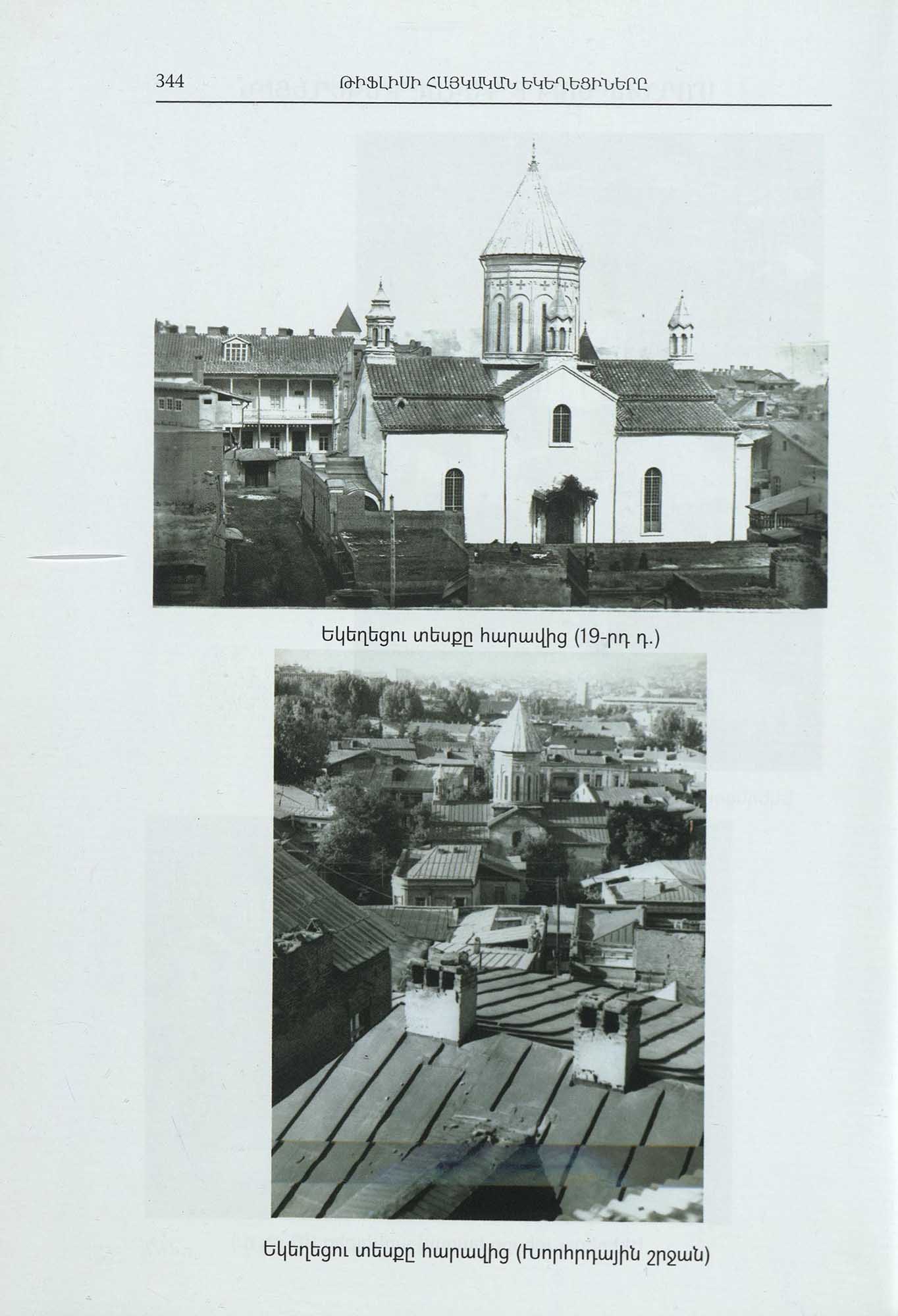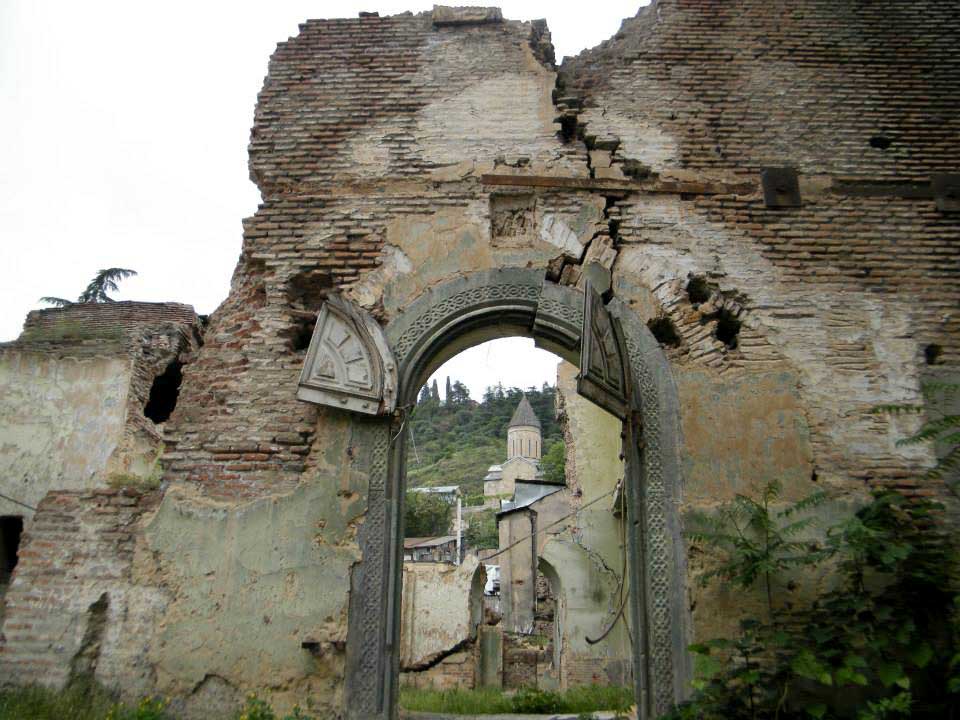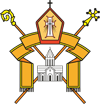SAINT GEVORK OF MUGHNI (MUGNU METS) CHURCH
THE CHURCH WAS ESTABLISHED IN 1356, IT IS ALSO MENTIONED IN 1537. ON NOVEMBER 19, 2009, THE CHURCH PARTIALLY COLLAPSED, AND NOW IT IS ON THE EDGE OF COLLAPSE.
Establishment: The once famous Saint Gevork of Mughni church in Tiflis, located on Beglar Akhospireli (Kala district) N6 street, after being confiscated during the Soviet era, gradually damaged and decayed over the years, is now among the ruined churches, almost on the edge of destruction.
According to Armenian historian Zakaria Kanakertsi, the church got its name from the church of the same name in Mughni village, not far from Ashtarak city. Once, in order to heal the heir of one of the Georgian kings, the relics of St. Gevork were brought from Hovannavank to Tiflis. Although the prince died while the relics were still on the way, when they arrived, they were transferred to the newly built church and buried there. The newly built church was named Saint Gevork of Mughni of Tiflis[1].
There are many views and hypotheses in scientific circles regarding the year of the foundation of St. Gevork church. Some of the researchers, based on the following testimony, mention 1537 (Pl. Ioseliani), others - 1751: “Adjacent to Prince Behbutov's Palace, there is a domed church dedicated to St. Geovork of Mughni, standing on four pillars. In addition to the large dome, three smaller domes are built on the outside at the three corners of this church. One of these three domes is for bells and the (other) two are empty. It was built at the expenses of citizens (mokalakis) Mandenov, Bastamov and Bashinjaghyan…[2]. However, regarding the foundation of the church, there is also the view that it was built in 1356. Among the existing sources, a "Sharaknots" copied in 1485 is especially worthy of attention, where it is written: “...was written my letter which calls Sharaknots by the hand of an unworthy writer of Mkrtchi churchwarden, in the name of the Armenian year of 1356, my holy songbook was written in my city T՛pkhis, with Saint Hovnan the Catholicos and doctor of pains Saint Geovork of Mughni”[3]. It is worth paying attention to the fact that the text mentions the name of St. Gevork of Mughni, which means that the church existed before the mentioned date. Accordingly, it is more likely that the church was built in the 14th century. It can be assumed that the mentions of the later period perhaps refer to the fundamental repairs of the church, and the aforementioned three families were the rebuilders of the church in 1751, and not the founders. Nevertheless, in the following manuscripts of the 15th century, the church is mentioned by its names, as well as by the names "Kamakatar Sourb Astvatsatsin" and "Geovork the Warrior".
In 1763 St. Gevork of Mughni church is mentioned as: "...The fate of Halghbatu monastery"[4]. In 1784 the church was one of the 7 Armenian churches of Tiflis belonging to the Haghpat Diocese[5].
 Reconstructions: The church underwent regular renovations, but in 1795 it was destroyed during the conquest of Agha-Mohammed Khan. In particular, it was thoroughly renovated in 1751, and in 1789 the belfry was built. The so-called inscription stone[6] reported information about the renovation in 1751, which, however, has not been preserved. During the renovation in 1900, the fact of church’s belfry being constructed became known: “During the demolition of the belfry of St. Geork of Mughni church in Tbilisi, a stone was found with the following inscription in Georgian: I built this belfry, the sinful Esther, the maidservant of Ter Shmavoneants Zurab, and the wife of Zurab, 1789”[7].
Reconstructions: The church underwent regular renovations, but in 1795 it was destroyed during the conquest of Agha-Mohammed Khan. In particular, it was thoroughly renovated in 1751, and in 1789 the belfry was built. The so-called inscription stone[6] reported information about the renovation in 1751, which, however, has not been preserved. During the renovation in 1900, the fact of church’s belfry being constructed became known: “During the demolition of the belfry of St. Geork of Mughni church in Tbilisi, a stone was found with the following inscription in Georgian: I built this belfry, the sinful Esther, the maidservant of Ter Shmavoneants Zurab, and the wife of Zurab, 1789”[7].
In the 50s of the 19th century, the church was again in a dilapidated condition and about 4500 rubles (silver drams) were needed to restore it[8]. In 1858, the parishioners of the church and the churchwarden Gevorg Mandinyants asked the renovator of churches, and the latter to the consistory, which gave the appropriate permission to repair the church[9]. Later, in 1860, it was planned to carry out the construction of the wall of the church, which entailed the expenditure of about 10,000 rubles in silver[10]. Before that, in 1859, the parishioners of the church had already prepared a special paper with the request for the construction of the church wall. The Diocesan Primate Archbishop Sargis Jalalyants also addressed the Catholicos regarding the issue [11]. Soon the permission of the Synod was also received[12]. In 1861, the permission by the Viceroy of Caucasus to enlarge the area around the church followed[13]. The next renovation works were also undertaken in the 90s of the 19th century.
Architecture: St. Gevork of Mughni church belongs to the type of domed basilica. The dome of the church rises in the middle of the total volume of the building, on four large, cylindrical pillars. On both sides of the semi-circular High Altar there are small sacristies with apses, which are not included in the rectangular border of the walls, but come out in semi-circular volumes typical of Byzantine architecture[14]. A detailed description of the church was also given by Egn. Ioseliani [15].
Clergy and churchwardens: Senior priest Lazar, Rev. Fathers Avetik Ter-Avetisyants, Hakob Dovlatyants, Sargis Malkhasyants of Ter-Harutyun were prists of the St. Gevork of Mughni church[16]. Among the churchwardens were Vasil Khojayants [17], Prince Arsen Behbyutyants[18], aforementioned Gevorg Mandinyants and others.
School: Both male and female schools operated adjacent to St. Gevork of Mughni church. The male school was opened in the 40s and 50s of the 19th century. It operated intermittently until 1914 [19]. On June 17, 1869, on the day of the Commemoration of St. Gayane and her Companions, the famous Gayaniants female school was opened[20]. The first inspector of the school was Zakaria Grigoryan, and the teacher was Mariam Shahparonyan[21]. Among the teachers were Rev. Fathers Sahak Sahakyan, Isahak Harutyunyan, Mariam Aslamazyan, and Yeghisabet Patkanyan. Religion, Armenian language, natural sciences, singing, Russian language, arithmetic, calligraphy, drawing, and handicraft were taught at the school[22]. In 1896, the school was closed, and the money it had was handed over to the administration of the consistory of the Diocese of Georgia and Imereti of the Armenian Apostolic Church. In 1906, around 25,625 rubles [23] were deemed untouchable by the Kondak No. 512 of Catholicos Mkrtich dated April 29 of the same year and placed in the Tiflis royal mint[24]. In the same year, 1906, trustees of the school appealed to the diocesan primate with a request to reopen the school[25]. In 1906-1907, the teaching staff list of the reopened school had already been compiled and sent to the diocesan primate for approval. Levon Seghbosyan (Shant) was nominated for the inspector position[26].
A preschool was opened adjacent to the church in 1880 on the initiative of Sofia Babayan, which operated until 1885[27].
Properties: Like other diocesan churches, St. Gevork of Mughni also had its own movable and immovable estates, which were recorded in the property registers of the diocesan churches. According to the 1837 documents of church estates of the diocese, in addition to various church items, the church had two stalls in the Bazarkhana district of Tiflis (on the Maidan side), three houses available for rent on the east side of the church. The church also had serfs[28]. In the first decade of the 20th century, one three-story and one two-story houses around the church and two stalls in the so-called 5th district of the city continued to belong to St. Gevork of Mughni church. During the mentioned period, the main amount of the church was about 2827 rubles and 75 kopecks with silver, and income: 2814 rubles and 12 kopecks with silver[29]. The church also had interest-bearing papers (N 67043) and royal treasury bonds (N 3081)[30]. In the list of documents preserved in the National Archive, there is also the expenses and revenue register of St. Gevork of Mughni church from 1826-1830[31].
St. Gevork of Mughni church in the Soviet period: In 1923-1930, St. Gevork of Mughni church remained under the jurisdiction of the diocesan authorities[32], but after the 1930s, it was turned into an ethnographic museum and then into a warehouse[33]. Over the years, despite being used as a warehouse the building was neglected, resulting in gradual damage and decay. In the 1980s, very dangerous cracks for the structure appeared on the walls of the church, and in the 1990s it was already declared unsafe and was permanently closed.
At dawn on November 19, 2009, Armenian St. Gevork of Mughni church, built in 1356, collapsed in Tbilisi. The dome of the church, the altar, the northern and southern arches collapsed, and only the western part and the belfry were standing. But over the years, it too appears on the edge of collapse. The Armenian side has repeatedly warned the Georgian authorities that the church is in a terrible condition.
The condition of the church continues to be fatal even today. On the issue, the Armenian Diocese in Georgia has repeatedly (2015) appealed to the relevant authorities, up to the Prime Minister of Georgia (2009, 2012) and the Speaker of the Parliament (2009). The concern of the Armenian Diocese in Georgia is that the Ministry of Culture and Monument Protection of Georgia, on whose balance sheet the church is listed, has left it to neglect, and the Patriarchate of Georgia and the state authorities, not resolving the issue of returning Armenian churches to the Diocese, are indirectly contributing to the destruction of Armenian cultural monuments in the territory of Georgia.
Residents living near St. Gevork of Mughni church proposed to dismantle the church area. This means to demolish and remove the remnants of the church due to the risk of further collapse. They have applied several times to the National Agency for the Protection of Cultural Heritage of the Ministry of Culture of Georgia, which is currently investigating the collapse and removing the collapsed fragments from the area.
[1] See about that in Zakariy Kanakertsi, Chronicle, Moscow, 1969; see also J.Chardin, Voyages du chevalier Chardin en Perse et autres lieux de l'Orient, par. L. Langles`, t. 2, Paris 1811:
[2] L. Melikset-Bek, Georgian sources about Armenia and the Armenians, Vol. 3, Yerevan, 1955, p. 22:
[3] P. Muradyan, Armenian churches of Old Tiflis, St. Etchmiadzin, 2009 p. 52:
[4]S. Yerevantsi, Jambr, Vagharshapat, 1873, p. 49:
[5] Ghukas Karnetsi, Divan of Armenian History, Norshark, vol. 1., Yerevan, 1984, p. 479:
[6] Guldenstedt made the first attempt to decipher the inscription. See the German original and the Georgian translation: «გიულდენშტედტის მოგზაურობა საქართველოში», ტ. II, თბ. 1964, გვ. 300: the inscription was also published by P. Muradyan (Armenian Epigraphy of Georgia, Yerevan, 1988, p. 45):
[7] ”Byzantion”, November 2, 1900, N 1241, p. 3:
[8] NAA, ֆ. 56, ց. 18, գ. 5, թ. 28 և շրջ.:
[9] NAA, ֆ. 56, ց. 5, թղթ. 43, վավ. 149, թ. 219 և շրջ.:
[10] NAA, ֆ. 53, ց. 1, գ. 3323, թ. 1:
[11] NAA, ֆ. 56, ց. 1, գ. 3968, թ. 2-5:
[12] NAA, ֆ. 56, ց. 1, գ. 3968, թ. 6 շրջ.-ով:
[13] NAA, ֆ. 56, ց. 1, գ. 3323, թ. 11:
[14] M. Hasratyan, The architecture of the Armenian churches of Tbilisi, “Etchmiadzin”, 2009/6/, p. 71:
[15] About that, see P. Muradyan, in the same place, p. 231: L. Melikset-Bek, in the same place.
[16] NAA, ֆ. 53, ց. 1, գ. 48, մաս 4, թթ. 669-677, (For the list of church parishioners in 1841, see A. Asatryan, St. Gevork of Mughni and St. Nshan churches, St. Etchmiadzin, 2016, p. 164-184:
[17] NAA, ֆ. 56, ց. 5, թղթ. 94, վավ. 305:
[18] NAA, ֆ. 53, ց. 1, գ. 1221, թ. 38:
[19]A. Asatryan, St. Gevork of Mughni and St. Nshan churches, St. Etchmiadzin, 2016, p. 127:
[20] “Meghu Hayastani” weekly newspaper, June 21, 1869, N 23, see also T. Vardanyan, Armenians of Tiflis and nearby settlements V-XXI centuries, p. 22:
[21] A. Asatryan, in the same place, p. 130:
[22] NAA, ֆ. 56, ց. 15, գ. 314, թ. 6:
[23] NAA, ֆ. 53, ց. 1, գ. 4038, թ. 1-2 շրջ.-ով, 12-13 շրջ.-ով:
[24] NAA, ֆ. 53, ց. 1, գ. 198, թ. 10:
[25] NAA, ֆ. 35, ց. 1, գ. 198, թ. 1:
[26] NAA, ֆ. 53, ց. 1, գ. 198, թ. 7:
[27] A. Asatryan, in the same place, p. 147:
[28] NAA, ֆ. 56, ց. 6, գ. 39, թ.17-26:
[29] NAA, ֆ. 56, ց. 15, գ. 795/մաս 3/, թ. 287 շ.-288:
[30] NAA, ֆ. 53, ց. 1, գ. 1221, թ. 12:
[31] NAA, ֆ. 53, ց. 1, գ. 18, թ. 1-5 շրջ.-ով:
[32] Documents on the history of the Armenian Church, Yerevan, 1997, p. 526:
[33] A. Asatryan, in the same place, p. 123:
 Հայերեն
Հայերեն  ქართული
ქართული  English
English  Русский
Русский 


